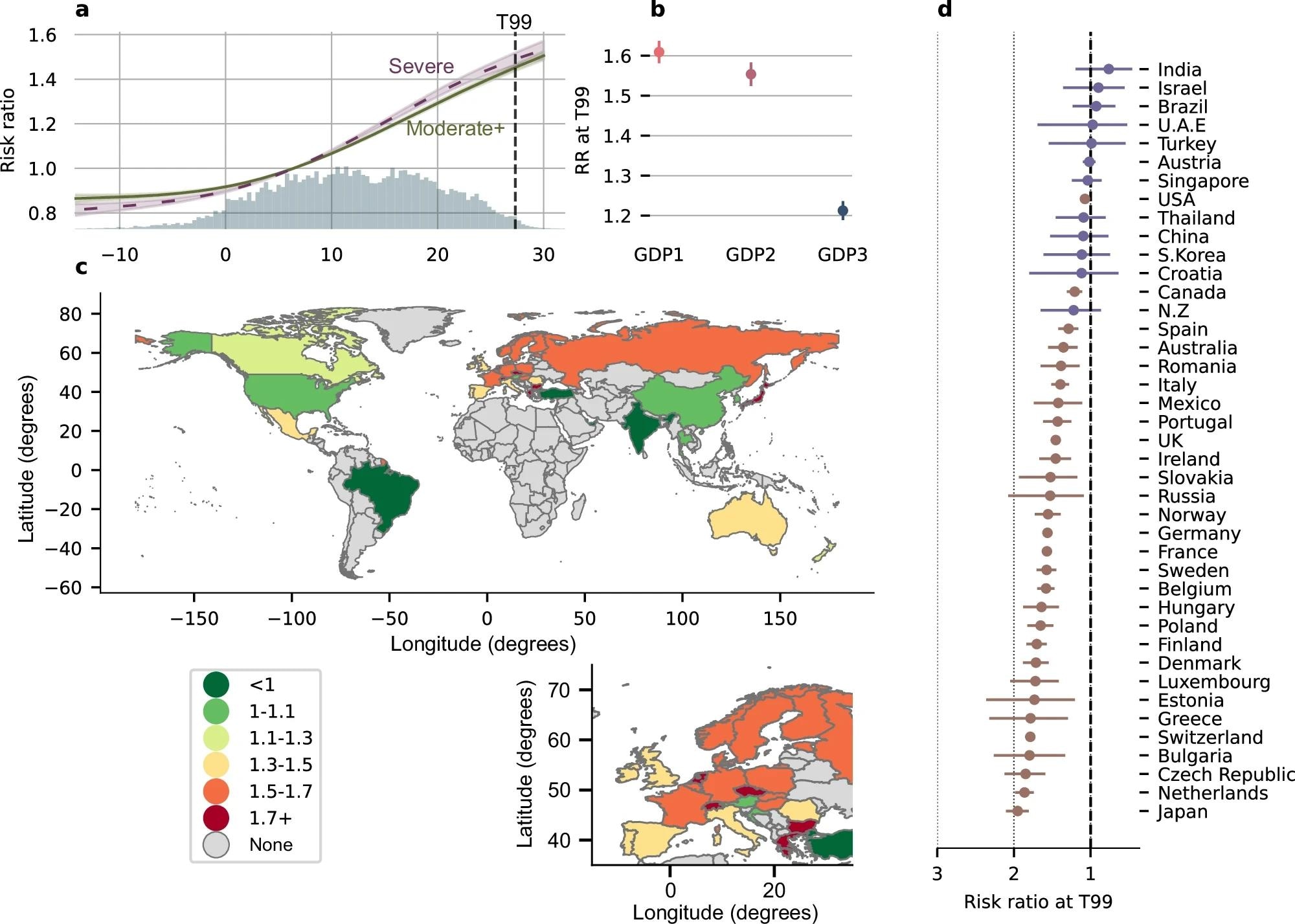New research reveals that rising global temperatures are fueling a sharp increase in sleep apnea cases, threatening health and workplace productivity worldwide unless urgent action is taken.
 Study: Global warming may increase the burden of obstructive sleep apnea. Image Credit: Mongkolchon Akesin / Shutterstock
Study: Global warming may increase the burden of obstructive sleep apnea. Image Credit: Mongkolchon Akesin / Shutterstock
In a recent article published in the journal Nature Communications, researchers analyzed how ambient temperature affects the severity of nightly obstructive sleep apnea (OSA) and estimated the related global well-being and productivity impacts under various global warming scenarios.
They found that as temperatures increased from 6.4°C to 27.3°C, the nightly probability of experiencing moderate-to-severe OSA rose by 45%, linking warming in 2023 to a loss of nearly 790,000 healthy life-years and a combined economic impact of approximately $98 billion USD, including $68 billion in wellbeing costs and $30 billion in workplace productivity losses.
These quantitative health and economic impacts are specifically based on data from 29 countries where a statistically significant association between temperature and OSA prevalence was identified.
Background
In 2023, the northern hemisphere experienced record-high temperatures, reaching over 2°C above pre-industrial levels. Without further reductions in greenhouse gas emissions, global temperatures are expected to rise by 2.1 to 3.4°C by the end of the century.
High temperatures already have well-known negative health impacts, including lower physical activity, poorer mental health, and higher mortality. Additionally, warmer nights have been shown to decrease sleep duration and quality, nearly doubling the prevalence of short sleep, which in 2023 alone may have caused a loss of 3.9 million healthy life years.
OSA, the most common sleep-related breathing disorder, affects nearly one billion adults worldwide. It is measured by the apnea-hypopnea index (AHI), which counts breathing disruptions per hour of sleep.
Untreated OSA is linked to higher mortality, multiple health problems, and road safety risks. Additionally, it could result in significant economic losses through increased absenteeism and reduced workplace productivity, costing billions of dollars annually.
Some research has linked outdoor temperatures to OSA severity; however, most studies were limited by single-night data and cross-sectional designs, which overlook night-to-night AHI variation. Moreover, the broader economic and social burden of increased OSA due to global warming has not been quantified.
About the study
This study used retrospective data from 125,295 adults worldwide who used an under-mattress sleep sensor between January 2020 and September 2023.
Participants were required to have at least 28 nights of data, with a minimum of four recordings per week. Demographics were self-reported, and geo-localization was limited to the nearest city to protect privacy. Country-level life expectancy, population, and gross domestic product (GDP) were sourced from global datasets.
The device estimated nightly breathing patterns and sleep, including AHI. Nights with less than five hours of sleep were excluded. Weather data, including air quality, humidity, temperature, and other conditions, were matched daily for each user’s location using validated climate datasets and future projections.
The study employed robust case-time series design and non-linear fixed-effect models, with distributed lag structures, to estimate how daily average temperatures affected nightly OSA risk, considering lags of up to four days. Models adjusted for air quality, time trends, weather, and sleep time variation. Subgroup analyses explored GDP levels, habitual sleep duration, age, sex, and body mass index (BMI).
Future global warming impacts on OSA prevalence were projected by comparing daily temperatures to historical averages, translating the risk into health burdens and workplace productivity losses.
 a Exposure-response curves between temperature and the risk ratio (RR) for nightly OSA (solid green) or nightly severe OSA (dashed purple). Shaded area represents 95%CI. Distribution of temperature (histogram) and temperature at the 99th percentile (T99; dashed black line) are also highlighted. b Subgroup analyses including the mean RR (and 95%CI) for nightly OSA at T99 based on the country of residence’s gross domestic product (GDP) per capita (tertiles – N, tertile 1 :40152; tertile 2: 37722; tertile3: 38468). c RR for nightly OSA at T99 by geographical location. d Country by country analysis with mean RR (and 95%CI) for nightly OSA at 99th vs. 25th percentile of temperature (brown indicates p-values < 0.05 and purple p-values > 0.05).
a Exposure-response curves between temperature and the risk ratio (RR) for nightly OSA (solid green) or nightly severe OSA (dashed purple). Shaded area represents 95%CI. Distribution of temperature (histogram) and temperature at the 99th percentile (T99; dashed black line) are also highlighted. b Subgroup analyses including the mean RR (and 95%CI) for nightly OSA at T99 based on the country of residence’s gross domestic product (GDP) per capita (tertiles – N, tertile 1 :40152; tertile 2: 37722; tertile3: 38468). c RR for nightly OSA at T99 by geographical location. d Country by country analysis with mean RR (and 95%CI) for nightly OSA at 99th vs. 25th percentile of temperature (brown indicates p-values < 0.05 and purple p-values > 0.05).
Key Findings
This large study analyzed around 62 million nights of sleep data from 116,620 regular users of an under-mattress sensor, mostly middle-aged men. Overall, 25.4% had moderate-to-severe OSA and 8.9% had severe OSA.
OSA prevalence ranged from 15% to 32% across 41 countries. Higher ambient temperatures were strongly linked to increased risk of nightly OSA: globally, on the hottest days (27.3°C), the chance of OSA was 45% higher than on cooler days (6.4°C), and severe OSA risk was 49% higher.
This temperature effect was stronger in lower-income countries, among males, individuals with a higher BMI, and those who slept more than six hours. Age did not significantly alter this link. Temperature-related increases in OSA prevalence translated into considerable health and economic burdens.
In 2023 alone, London’s warming added about 150 million extra OSA person-days, resulting in a loss of over 59,000 disability-adjusted life years (DALYs). Across 29 countries with significant temperature–OSA associations, warming-related OSA increases cost approximately $68 billion in wellbeing losses and $30 billion in workplace productivity losses in 2023 and are projected to grow further.
Rising OSA also led to higher workplace losses, with an estimated 80 million more days of reduced productivity (presenteeism) and 25 million extra absenteeism days in 2023, costing $30 billion. These impacts are expected to increase by 1.2 to 3 times by 2100 under scenarios with temperatures ≥1.8°C above pre-industrial levels, rather than only double. However, the authors note in the discussion that "the OSA burden may double by 2100," making "double or more" a reasonable summary.
Conclusions
This study highlights that high ambient temperatures significantly increase the risk of moderate-to-severe OSA worldwide, with warming-related OSA in 2023 alone linked to nearly 800,000 lost healthy life years and an estimated combined economic cost of about $98 billion USD.
If global warming continues under current policies, the OSA burden could increase by 1.2 to 3 times by 2100 (i.e., double or more), adding substantial health and economic impacts.
A key strength of this analysis is the large, multi-night dataset, which utilizes validated under-mattress sensors, providing reliable OSA estimates. The use of advanced time-series and non-linear modeling supports the robustness of these findings, though the authors note that residual confounding and unmeasured factors may still influence results. However, limitations include the underrepresentation of lower socioeconomic groups, lack of precise indoor temperature and air pollution data, and limited information on co-morbidities and daytime symptoms.
The sample was predominantly male and from developed countries, which may have led to an underestimation of the true global burden. Additionally, unmeasured factors, such as rising BMI and varied adaptation measures, may affect the estimates.
Overall, the findings emphasize the urgent need to limit global warming and enhance global sleep health data and adaptation strategies to mitigate the rising OSA burden associated with higher temperatures.
Journal reference:
- Global warming may increase the burden of obstructive sleep apnea. Lechat, B., Manners, J., Pinilla, L., Reynolds, A.C., Scott, H., Vena, D., Bailly, S., Fitton, J., Toson, B., Kaambwa, B., Adams, R.J., Pepin, J., Escourrou, P., Catcheside, P., Eckert, D.J. Nature Communications (2025). DOI: 10.1038/s41467-025-60218-1, https://www.nature.com/articles/s41467-025-60218-1